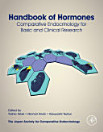Handbook of Hormones: Comparative Endocrinology for Basic and Clinical Research, Edition 2
Hironori Ando · Kazuyoshi Ukena · Shinji Nagata
Jul 2021 · Academic Press
Ebook
1174
Pages
family_home
Eligible
info
reportRatings and reviews aren’t verified Learn More
About this ebook
Handbook of Hormones: Comparative Endocrinology for Basic and Clinical Research, Second Edition presents a catalog of fundamental information on the structure and function of hormones from basic biology to clinical use, offering a rapid way to obtain specific facts about the chemical and molecular characteristics of hormones, their receptors, signaling pathways, and the biological activities they regulate. The book's stellar editorial board, affiliated with the Japan Society for Comparative Endocrinology, brings together authors that present a compelling structure of each hormone with a consistent presentation that provides a primer surrounding the plethora of hormones that now exist. Comparative endocrinology continues to rapidly expand and new information about hormones is being produced almost daily, making it important to stay up-to-date. Hormone, paracrine, and autocrine factors have been identified as key players in a range of different systems, including immune, musculoskeletal and cardiovascular. Frontiers between disciplines are being blurred and many scientists in fields other than endocrinology are interested in hormones. Scientists now have the unprecedented opportunity to look from invertebrates to vertebrate and identify novel regulatory factors and understand their function and how they determine an organism's physiology and survival. - Presents hormones in groups according to their origin so that readers can easily understand their inter-relation - Includes 47 new hormones, such as neuropeptides, cytokines, growth hormones, biogenic amines and amino acids that are important for cell to cell communication via endocrine, paracrine and neurotransmitter signaling - Summarizes the current knowledge of hormone evolution based on comparative genome resources, such as synteny, genome sequence and comprehensive phylogeny - Covers a wide range of information on hormones, from basic information on structure and function across vertebrate and invertebrate phyla to clinical applications - Collates key information on 259 hormones and 47 groups/families
About the author
Graduate School of Integrated Arts and Sciences, Hiroshima University, Hiroshima, Japan. Professor Ukena discovered NPGL, a brain chemical that regulates hunger and fat storage in mammals, shows that hunger and energy consumption mechanisms are even more complex than we realized and has broad clinical and societal implications for the study and treatment of obesity and its associated diseases.
Rate this ebook
Tell us what you think.
Reading information
Smartphones and tablets
Install the Google Play Books app for Android and iPad/iPhone. It syncs automatically with your account and allows you to read online or offline wherever you are.
Laptops and computers
You can listen to audiobooks purchased on Google Play using your computer's web browser.
eReaders and other devices
To read on e-ink devices like Kobo eReaders, you'll need to download a file and transfer it to your device. Follow the detailed Help Center instructions to transfer the files to supported eReaders.





